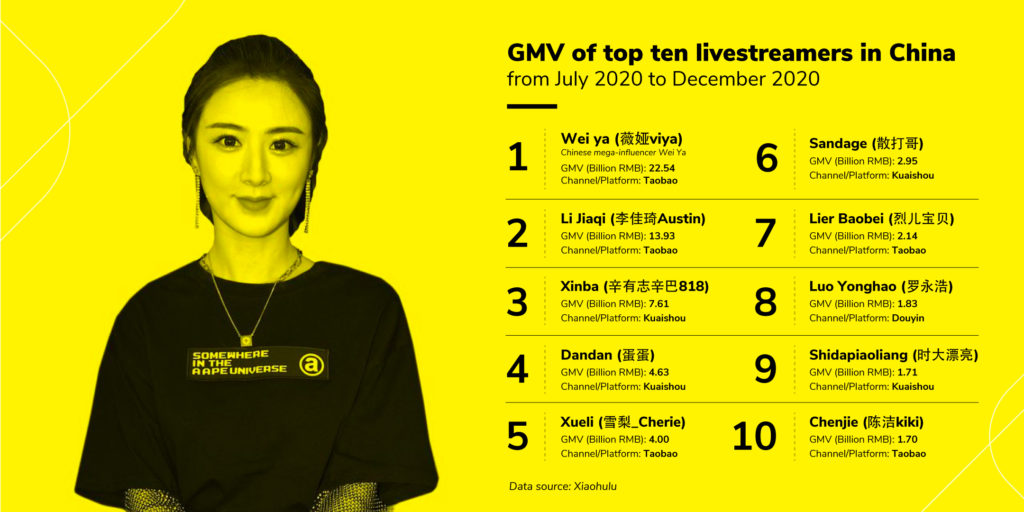Nowadays, the vast majority of the Gross Merchandise Value (GMV) of livestreaming e-commerce platforms is contributed by top livestreamers. These livestreamers belong to different multi-channel network (MCN) institutions, who provide resources for new livestreamers, and make profits by boosting e-commerce platforms’ sales through their massive promotional campaigns. Although the livestreamers market is highly competitive, it will be challenging to dethrone the top players from their positions.

Table 1: GMV of Top 10 livestreamers in China from Jul. 2020 to Dec. 2020
Between July 2020 to December 2020, the top ten livestreamers in China have already hit record sales across different ecommerce platforms, yet Wei Ya and Li Jiaqi have clearly and significantly exceeded that of the rest in terms of GMV sales that they have pulled in. Both Wei Ya and Li Jiaqi have their own particular livestreaming styles that have come to be widely accepted by audiences. What styles do they have, and how are they able to impact consumers’ decisions? Their success can be attributed to three important factors: the livestreamers themselves, the technology of the e-commerce platforms, and the changing consumer behavior in the Internet era.
Livestreamers: The bridge between brands and consumers
Livestreaming requires a blend of sales and online engagement, which plays to the strengths of both Wei Ya and Li Jiaqi. Wei Ya used to be a member of an idol group (An idol is an entertainer marketed for their image, attractiveness, and personality in Asian pop culture. They are primarily singers, but are also trained in other roles like acting, dancing, and modeling), and livestreaming has allowed her to display her natural charms in front of the camera. Born into a family of retailers, she used to own a clothing store before she started a career in the livestreaming industry. Similarly, Li Jiaqi was previously a salesperson in L`Oreal, where he won the title of ‘Sales Champion’ several times. Both influencers have built up a solid foundation in engaging audiences and sales before becoming popular livestreamers.
The most important thing however, is that they portray themselves as being on the side of their fans and consumers, instead of the brands and merchants. Their role in the entire purchasing cycle (from product selection to purchase completion) is perceived to be representative of consumers themselves. They position themselves as a consumer, negotiate with the brands to obtain the most attractive discounts, and then subsequently introduce these products to consumers. Their products introductions and demonstrations are done in an honest and transparent manner, and most importantly, in a way relatable to the consumers (i.e., the product is described in a way that consumers can understand) and further enhanced through their own unique catch phrases (like “OMG” and “Buy it, buy it, buy it”; the latter is Li Jiaqi’s common catch phrase used to differentiate himself from other livestreamers). Finally, they leverage their influence and persuasiveness to get a purchase guarantee from the brands (such as a seven-day return guarantee, and/or a payback credit 10 times the dollar value of any fake goods sold!) and help to ensure that the brands actually commit to the guarantees.
Their live engagement with viewers, which come across as authentic, yet interesting, enables them to win the trust of their consumers, and sell out products in just a matter of a few seconds. The reputation and loyal following that they have built up also enables them to sell almost anything, even most recently when Wei Ya sold a rocket launch on her livestream for around 40 million RMB. Livestreamers have created an addictive virtual environment that hooks their fans to tune in regularly to watch their livestream and buy into their promotions. In May 2020, Weiya hit a record-high audience of over 37 million – more than that of the ‘Game of Thrones’ finale, the Oscars or even the NFL’s Sunday Night Football’!
Technology boom: The advent of the livestreaming era
The boom of livestreaming e-commerce has seen it grow into a burgeoning industry, rather than being just a small-time business run by enterprising individuals. The success of these popular livestreams can be credited not just to the livestreamers themselves, but is also largely a reflection of the entire development of the livestreaming industry chain.
Firstly, livestreaming is a service inseparable from service providers, ie e-commerce MCN companies who manage business opportunities for these livestreamers, akin to influencer agencies who manage their talents. For example, Wei Ya falls under the enterprise Qianxun Group, which provides talent management services to dozens of livestreamers, as well as volume retail and supply chain management. MCN enterprises like Qianxun Group also have plans to introduce consulting services and ad agency-type of services for brands that are seeking greater access to new audiences. Their suite of support allows mega-influencers like Wei Ya and other budding livestreamers to conduct successful livestreams with much less hassle.
Secondly, the development of livestreaming capabilities across major Chinese tech platforms have greatly boosted the livestreaming space. For example, e-commerce platform Taobao has greatly leveraged its parent company Alibaba’s livestreaming platforms. Once viewers log in to watch the stream via their Taobao accounts, their shipping addresses and payment information are already stored, which allows consumers to complete purchases with convenience without having to move out of the app. Furthermore, integrated cloud services such as Aliyun (Alibaba Cloud) also allows viewers to enjoy high-quality and stable livestreams on these platforms.
Thirdly, the ecommerce livestreaming supply chain has grown collectively as an industry, creating a seamless and end-to-end transactional ecosystem for consumers. Taobao and Tmall provide the shopping sites; Alipay and Ant Credit provide financial services for payments; Cainiao Logistics handles shipping and returns! This integrated ecosystem has led to tremendous growth in volume of sales over the last couple of years.
Finally, for many Chinese who are part of a mobile-first generation, their phones and apps have become a part of their life, and this has contributed to consumers’ preference for accessibility and convenience. Chinese consumers are now accustomed to online shopping, fast shipping, livestreaming, interactive online communities and more. Livestreaming e-commerce serves to meet their various needs – from shopping to fun and entertainment; and they can participate in it at any time and from anywhere.
The success of these top livestreamers in China reflects the huge potential of how big the livestreaming industry can become. It is one of the important consumer innovations in our world today and its successful integration into our daily lives depends on the efforts of companies in the livestreaming supply and value chain. As for how livestreaming will continue to grow in China, as well as how other ecosystems around the world will adapt to it – only time will tell.








